Accurate Identification of Partial Discharge Signals in Cable Terminations of High-Speed Electric Multiple Unit Using Wavelet Transform and Deep Belief Network
Abstract
1. Introduction
2. Partial Discharge Data Acquisition
3. Classification Algorithm Design
3.1. Noise Reduction Based on Wavelet Transform
3.2. Deep Belief Network
3.3. WT-DBN Classification Steps
4. Analysis of Classification Results
4.1. Influence of Different Stimulators on WT-DBN
4.2. Influence of WT on DBN Classification
4.3. The Impact of Training Sample Size on the Classification Results
4.4. Comparison of Recognition Results Using Different Methods
4.5. Validation of WT-DBN Model Utilizing Mixed Signals
5. Conclusions
- When selecting the sigmoid function as the activator for training the model, the average loss is low, the average accuracy is higher, and the training model is much more stable.
- The WT-DBN presented in this study is compared with DBN in terms of classification effect, where wavelet transform eliminates white noise interference from the raw signals.
- The evaluation of WT-DBN’s classification effectiveness with varying quantities of training dataset shows that increased dataset for training improves classification precision. When the quantity of the training dataset amounts to 30 instances, the accuracy can reach over 94%. This enhances the usability of the input dataset, making the model more flexible for various situations.
- By comparing the three methods of WT-DBN, WT-BP, and WT-SVM, the proposed WT-DBN achieves a recognition accuracy of 98.75% compared to the other methods.
- By training the WT-DBN model with 150 sets of standard signals, the model is used to identify mixed signals, effectively recognizing partial discharge signals and partial discharge mixed with corona interference and removing corona discharge.
Author Contributions
Funding
Institutional Review Board Statement
Informed Consent Statement
Data Availability Statement
Conflicts of Interest
References
- Xin, D.; Wu, G.; Chen, K.; Liu, K.; Xie, Y.; Gao, G.; Xiao, S.; Tang, Y.; Sun, C.; Lin, M. Research on the evolution characteristics of interfacial defect inside the vehicle-mounted high-voltage cable termination for high-speed trains. CSEE J. Power Energy Syst. 2023, 1–13. [Google Scholar] [CrossRef]
- Yang, Y.; Li, J.; Chen, Z.; Liu, Y.-C.; Chen, K.; Liu, K.; Xin, D.-L.; Gao, G.; Wu, G. Classification of partial discharge in vehicle-mounted cable termination of high-speed electric multiple unit: A machine learning-based approach. Electronics 2024, 13, 495. [Google Scholar] [CrossRef]
- Sun, C.; Wu, G.; Pan, G.; Zhang, T.; Li, J.; Jiao, S.; Liu, Y.-C.; Chen, K.; Liu, K.; Xin, D.; et al. Convolutional neural network-based pattern recognition of partial discharge in high-speed EMU cable termination. Sensors 2024, 24, 2660. [Google Scholar] [CrossRef] [PubMed]
- Li, C.; Tohid, S.; Mohamadreza, A.B.; Kerry, D.; Cao, Y.; Zhang, D. Understanding of DC partial discharge: Recent progress, challenges, and outlooks. CSEE J. Power Energy Syst. 2022, 3, 8. [Google Scholar]
- Tang, Y.; Gao, G.; Liu, K.; Chen, K.; Xie, Y.L.; Xin, D.L.; Zhou, S.Y.; Wu, G. Electric field distribution and performance optimization of high-speed train cable termination with internal defects. Eng. Fail. Anal. 2023, 151, 107360. [Google Scholar] [CrossRef]
- Zhou, L.; Bai, L.; Zhang, J.; Cao, W.; Xiang, E. Measurement and diagnosis of PD characteristics of industrial cable terminations in extreme cold environment. IEEE Trans. Instrum. Meas. 2021, 70, 1–11. [Google Scholar] [CrossRef]
- Wang, P.Y.; Ma, H.; Liu, G.; Han, Z.Z.; Guo, D.M.; Xu, T.; Kang, L.Y. Dynamic thermal analysis of high-voltage power cable insulation for cable dynamic thermal rating. IEEE Access 2019, 7, 56095–56106. [Google Scholar] [CrossRef]
- Li, S.; Cao, B.; Cui, Y.; Kang, Y.; Gao, S.; Li, H.; Dong, H. Terahertz-based insulation delamination defect inspection of vehicle cable terminals. IEEE Trans. Transp. Electrif. 2022, 9, 1765–1774. [Google Scholar] [CrossRef]
- Du, B.X.; Zhu, X.H.; Gu, L.; Liu, H.J. Effect of surface smoothness on tracking mechanism in XLPE-Si-rubber interfaces. IEEE Trans. Dielectr. Electr. Insul. 2011, 18, 176–181. [Google Scholar] [CrossRef]
- Chen, X.; Xu, Y.; Cao, X.; Gubanski, S.M. Electrical treeing behavior at high temperature in XLPE cable insulation samples. IEEE Trans. Dielectr. Electr. Insul. 2015, 22, 2841–2851. [Google Scholar] [CrossRef]
- Zhu, B.; Jia, Z.; Hu, H.; Ouyang, X.G.; Wang, X.L. Relationship between the interfacial ramped DC breakdown voltage and the morphology of the XLPE/SiR interface. IEEE Trans. Dielectr. Electr. Insul. 2019, 26, 689–697. [Google Scholar] [CrossRef]
- Gao, G.; Tang, Y.; Cao, H.; Xin, D.; Xie, Y.; Chen, K.; Liu, K.; Wu, G. Research on electric field characteristics under different length interface air gap defects in cable terminations of high-speed train. Measurement 2024, 228, 114397. [Google Scholar] [CrossRef]
- Wang, T.; Li, J.; Liu, K.; Yuan, D.; Gao, G.; Xin, D.; Wu, G. Effect of air gap defects on the electric field distribution and partial discharge characteristics of vehicle-mounted high-voltage cable terminals. In Proceedings of the 2023 Panda Forum on Power and Energy, Chengdu, China, 27–30 April 2023. [Google Scholar]
- Choudhary, M.; Shafiq, M.; Kiitam, I.; Palu, I.; Hassan, W.; Singh, P.P. Investigation of partial discharge characteristics in XLPE cable insulation under increasing electrical stress. Eng. Fail. Anal. 2024, 158, 108006. [Google Scholar] [CrossRef]
- Li, S.; Song, P.; Wei, Z.; Li, X.; Tang, Q.; Meng, Z.; Li, J.; Liu, S.T.; Wang, Y.H.; Li, J. Partial discharge detection and defect location method in GIS cable terminal. Energies 2022, 16, 413. [Google Scholar] [CrossRef]
- Blackburn, T.R.; Phung, B.T.; Hao, Z. On-line partial discharge monitoring for assessment of power cable insulation. In Proceedings of the 2005 International Symposium on Electrical Insulating Materials, Kitakyushu, Japan, 5–9 June 2005. [Google Scholar]
- Ma, G.-M.; Li, C.-R.; Chen, X.-W.; Jiang, J.; Ge, Z.-D.; Chang, W.-Z. Numerical sensor design for partial discharge detection on power cable joint. IEEE Trans. Dielectr. Electr. Insul. 2015, 22, 2311–2319. [Google Scholar] [CrossRef]
- Zhang, X.; Pang, B.; Liu, Y.; Liu, S.; Xu, P.; Li, Y.; Liu, Y.F.; Qi, L.J.; Xie, Q. Review on detection and analysis of partial discharge along power cables. Energies 2021, 14, 7692. [Google Scholar] [CrossRef]
- Bin, F.; Wang, F.; Sun, Q. Identification of ultra-high-frequency PD signals in gas-insulated switchgear based on moment features considering electromagnetic mode. High Volt. 2020, 5, 688–696. [Google Scholar] [CrossRef]
- Waqar, H.; Muhammad, S.; Amjad, G.H. Investigating the progression of insulation degradation in power cable based on partial discharge measurements. Electr. Power Syst. Res. 2023, 221, 109452. [Google Scholar]
- Miftahul, F.; Zulkurnain, M.A. Partial discharge diagnosis and remaining useful lifetime in XLPE extruded power cables under DC voltage: A review. Electr. Eng. 2023, 105, 4195–4212. [Google Scholar]
- Sheng, B.; Zhou, C.; Hepburn, D.M.; Dong, X.; Peers, G.; Zhou, W.; Tang, Z. Partial discharge pulse propagation in power cable and partial discharge monitoring system. IEEE Trans. Dielectr. Electr. Insul. 2014, 21, 948–956. [Google Scholar] [CrossRef]
- Zhong, J.; Bi, X.; Shu, Q.; Chen, M.; Zhou, D.; Zhang, D. Partial discharge signal denoising based on singular value decomposition and empirical wavelet transform. IEEE Trans. Instrum. Meas. 2020, 69, 8866–8873. [Google Scholar] [CrossRef]
- Zhou, K.; Li, M.; Li, Y.; Huang, Y. An improved denoising method for partial discharge signals contaminated by white noise based on adaptive short-time singular value decomposition. Energies 2019, 12, 3465. [Google Scholar] [CrossRef]
- Li, S.; Sun, S.; Shu, Q.; Chen, M.; Zhang, D.; Zhou, D. Partial discharge signal denoising method based on frequency spectrum clustering and local mean decomposition. IET Sci. Meas. Technol. 2020, 14, 853–861. [Google Scholar] [CrossRef]
- Tang, Y.; Tai, C.; Su, C.; Chen, C.Y.; Chen, J.F. A correlated empirical mode decomposition method for partial discharge signal denoising. Meas. Sci. Technol. 2010, 21, 1–11. [Google Scholar] [CrossRef]
- Gao, G.; Zhou, S.; Yang, S.; Chen, K.; Xin, D.; Tang, Y.; Liu, K.; Wu, G. Accurate identification partial discharge of cable termination for high-speed trains based on wavelet transform and convolutional neural network. Electr. Power Syst. Res. 2023, 225, 109838. [Google Scholar] [CrossRef]
- Lu, L.; Zhou, K.; Zhu, G.; Chen, B.; Yana, X. Partial discharge signal denoising with recursive continuous S-shaped algorithm in cables. IEEE Trans. Dielectr. Electr. Insul. 2021, 28, 1802–1809. [Google Scholar] [CrossRef]
- Long, J.; Wang, X.; Dai, D.; Tian, M.; Zhu, G.; Zhang, J. Denoising of UHF PD signals based on optimised VMD and wavelet transform. IET Sci. Meas. Technol. 2017, 11, 753–760. [Google Scholar] [CrossRef]
- Shams, M.A.; Anis, H.I.; El-Shahat, M. Denoising of heavily contaminated partial discharge signals in high-voltage cables using maximal overlap discrete wavelet transform. Energies 2021, 14, 6540. [Google Scholar] [CrossRef]
- Sun, K.; Zhang, J.; Shi, W.; Guo, J. Extraction of partial discharge pulses from the complex noisy signals of power cables based on CEEMDAN and wavelet packet. Energies 2019, 12, 3242. [Google Scholar] [CrossRef]
- Montanari, G.C.; Seri, P.; Ghosh, R.; Cirioni, L. Noise rejection and partial discharge source identification in insulation system under DC voltage supply. IEEE Trans. Dielectr. Electr. Insul. 2019, 26, 1894–1902. [Google Scholar] [CrossRef]
- Sun, K.; Li, R.; Zhao, L.; Li, Z. Feature extraction based on time-series topological analysis for the partial discharge pattern recognition of high-voltage power cables. Measurement 2023, 217, 113009. [Google Scholar] [CrossRef]
- Mishra, S.; Singh, P.P.; Kiitam, I.; Shafiq, M.; Palu, I.; Bordin, C. Diagnostics analysis of partial discharge events of the power cables at various voltage levels using ramping behavior analysis method. Electr. Power Syst. Res. 2024, 227, 4523468. [Google Scholar] [CrossRef]
- Zhao, Z.; Wu, J.; Li, T.; Sun, C.; Yan, R.; Chen, X. Challenges and opportunities of AI-enabled monitoring, diagnosis & prognosis: A review. Chin. J. Mech. Eng. 2021, 34, 56. [Google Scholar]
- Nor, A.K.M.; Pedapati, S.R.; Muhammad, M.; Leiva, V. Overview of explainable artificial intelligence for prognostic and health management of industrial assets based on preferred reporting items for systematic reviews and meta-analyses. Sensors 2021, 21, 8020. [Google Scholar] [CrossRef]
- Roumpakias, E.; Stamatelos, T. Health monitoring and fault detection in photovoltaic systems in central greece using artificial neural networks. Appl. Sci. 2022, 12, 12016. [Google Scholar] [CrossRef]
- Liu, Y.-C.; Laghrouche, S.; N’Diaye, A.; Narayan, S.; Cirrincione, G.; Cirrincione, M. Sensorless control of synchronous reluctance motor drives based on the TLS EXIN neuron. In Proceedings of the 2019 IEEE International Electric Machines & Drives Conference, San Diego, CA, USA, 12–15 May 2019. [Google Scholar]
- Zhang, S.; Zhang, S.; Wang, B.; Habetler, T.G. Deep learning algorithms for bearing fault diagnostics—A comprehensive review. IEEE Access 2020, 8, 29857–29881. [Google Scholar] [CrossRef]
- Liu, Y.-C.; Laghrouche, S.; N’Diaye, A.; Cirrincione, M. Hermite neural network-based second-order sliding-mode control of synchronous reluctance motor drive systems. J. Frankl. Inst. 2021, 385, 400–427. [Google Scholar] [CrossRef]
- Didier, F.; Liu, Y.-C.; Laghrouche, S.; Depernet, D. A comprehensive review on advanced control methods for floating offshore wind turbine systems above the rated wind speed. Energies 2024, 17, 2257. [Google Scholar] [CrossRef]
- Forootan, M.M.; Larki, I.; Zahedi, R.; Ahmadi, A. Machine learning and deep learning in energy systems: A review. Sustainability 2022, 14, 4832. [Google Scholar] [CrossRef]
- Zhang, B.; Ren, G. Li-ion battery state of charge prediction for electric vehicles based on improved regularized extreme learning machine. World Electr. Veh. J. 2023, 14, 202. [Google Scholar] [CrossRef]
- Guato Burgos, M.F.; Morato, J.; Vizcaino Imacaña, F.P. A Review of smart grid anomaly detection approaches pertaining to artificial intelligence. Appl. Sci. 2024, 14, 1194. [Google Scholar] [CrossRef]
- Ao, Y.; Liu, Y.-C.; Laghrouche, S.; Candusso, D. Dynamic fractional-order model of proton exchange membrane fuel cell system for sustainability improvement. Sustainability 2024, 16, 2939. [Google Scholar] [CrossRef]
- Wang, J.; Li, X.; Fei, J. Evaluation of interval type-2 fuzzy neural super-twisting control applied to single-phase active power filters. Appl. Sci. 2024, 14, 3271. [Google Scholar] [CrossRef]
- Zhu, Y.; Jia, Y.; Wang, L. Partial discharge pattern recognition method based on variable predictive model-based class discriminate and partial least squares regression. IET Sci. Meas. Technol. 2016, 10, 737–744. [Google Scholar] [CrossRef]
- Biswas, S.; Dey, D.; Chatterjee, B.; Chakravorti, S. An approach based on rough set theory for identification of single and multiple partial discharge source. Int. J. Electr. Power Energy Syst. 2013, 46, 163–174. [Google Scholar] [CrossRef]
- Hussain, M.R.; Refaat, S.S.; Abu-Rub, H. Overview and partial discharge analysis of power transformers: A literature review. IEEE Access 2021, 9, 64587–64605. [Google Scholar] [CrossRef]
- Gao, W.; Ding, D.; Liu, W. Research on the typical partial discharge using the UHF detection method for GIS. IEEE Trans. Power Deliv. 2011, 26, 2621–2629. [Google Scholar] [CrossRef]
- Pardauil, A.C.; Nascimento, T.P.; Siqueira, M.R.; Bezerra, U.H.; Oliveira, W.D. Combined approach using clustering-random forest to evaluate partial discharge patterns in hydro generators. Energies 2020, 13, 5992. [Google Scholar] [CrossRef]
- Basharan, V.; Maria, W.I.; Ramasamy, M. Recognition of multiple partial discharge patterns by multi-class support vector machine using fractal image processing technique. IET Sci. Meas. Technol. 2018, 12, 1031–1038. [Google Scholar] [CrossRef]
- Jineeth, J.; Mallepally, R.; Sindhu, T.K. Classification of partial discharge sources in XLPE cables by artificial neural networks and support vector machine. In Proceedings of the 2018 IEEE Electrical Insulation Conference, San Antonio, TX, USA, 17–20 June 2018. [Google Scholar]
- Sharkawy, R.M.; Mangoubi, R.S.; Abdel-Galil, T.K.; Salama, M.M.A.; Bartnikas, R. SVM classification of contaminating particles in liquid dielectrics using higher order statistics of electrical and acoustic PD measurements. IEEE Trans. Dielectr. Electr. Insul. 2007, 14, 669–678. [Google Scholar] [CrossRef]
- Behzad, M.; Asghari, K.; Eazi, M.; Palhang, M. Generalization performance of support vector machines and neural networks in runoff modeling. Expert Syst. Appl. 2009, 36, 7624–7629. [Google Scholar] [CrossRef]
- Jia, Y.; Zhu, Y. Partial discharge pattern recognition using variable predictive model-based class discrimination with kernel partial least squares regression. IET Sci. Meas. Technol. 2018, 12, 360–367. [Google Scholar] [CrossRef]
- Liu, T.; Yan, J.; Wang, Y.; Xu, Y.; Zhao, Y. GIS partial discharge pattern recognition based on a novel convolutional neural networks and long short-term memory. Entropy 2021, 23, 774. [Google Scholar] [CrossRef] [PubMed]
- Boczar, T.; Cichon, A.; Borucki, S. Diagnostic expert system of transformer insulation systems using the acoustic emission method. IEEE Trans. Dielectr. Electr. Insul. 2014, 21, 854–865. [Google Scholar] [CrossRef]
- Yu, Y.; Wang, Y.L.; Zhu, Y.B. Optimization of nesquehonite whisker preparation process based on BP neural network. China Powder Sci. Technol. 2024, 30, 103–113. [Google Scholar]
- Wang, Y.; Yan, J.; Yang, Z.; Zhao, Y.; Liu, T. GIS partial discharge pattern recognition via deep convolutional neural network under complex data source. IEEE Trans. Dielectr. Electr. Insul. 2018, 25, 678–685. [Google Scholar]
- Li, L.Q.; Wang, S.L. Neural network simulation of vibration mill’ s damper behavior. China Powder Sci. Technol. 2003, 4, 5–8. [Google Scholar]
- Chang, C.K.; Chang, H.H.; Boyanapalli, B.K. Application of pulse sequence partial discharge based convolutional neural network in pattern recognition for underground cable joint. IEEE Trans. Dielectr. Electr. Insul. 2022, 29, 1070–1078. [Google Scholar] [CrossRef]
- Xiao, S.; Liu, P.Y.; Chen, K.; Liu, K.; Gao, G.Q.; Wu, G.N. Battery state of health prediction based on voltage intervals BP neural network and genetic algorithm. Int. J. Green Energy 2024, 21, 1743–1756. [Google Scholar] [CrossRef]
- Peng, X.; Zhou, C.; Hepburn, D.M.; Judd, M.D.; Siew, W.H. Application of K-means method to pattern recognition in on-line cable partial discharge monitoring. IEEE Trans. Dielectr. Electr. Insul. 2013, 20, 754–761. [Google Scholar] [CrossRef]
- Alvarez, F.; Ortego, J.; Garnacho, F.; Sanchez-Uran, M.A. A clustering technique for partial discharge and noise sources identification in power cables by means of waveform parameters. IEEE Trans. Dielectr. Electr. Insul. 2016, 23, 469–481. [Google Scholar] [CrossRef]
- Wang, J.; Liu, B.; Zhang, C.; Yang, F.; Zhang, T.; Miao, X. GIS partial discharge type identification based on optimized support vector machine. In Proceedings of the 2019 IEEE 3rd International Electrical and Energy Conference, Beijing, China, 7–9 September 2019; pp. 516–520. [Google Scholar]
- Li, L.; Yuepeng, C.; Guang, Y.; Cuimin, M.; Huajun, Z. Type recognition of partial discharge source based on PCA and GWO-SVM. In Proceedings of the 33rd Chinese Control and Decision Conference, Kunming, China, 22–24 May 2021. [Google Scholar]
- Xue, L.; Li, X.F.; Ren, X.W.; Gou, J.J. Depression of narrowband periodic interference in PD signal of transformer based on mixed morphological filter. Transformer 2012, 49, 43–46. [Google Scholar]
- Karimi, M.; Majidi, M.; MirSaeedi, H.; Arefi, M.M.; Oskuoee, M. A novel application of deep belief networks in learning partial discharge patterns for classifying corona, surface, and internal discharges. IEEE Trans. Ind. Electron. 2020, 67, 3277–3287. [Google Scholar] [CrossRef]
- Peng, X.; Li, J.; Wang, G.; Wu, Y.; Li, L.; Li, Z.; Ashfaque, A.B.; Siew, W.H. Random forest based optimal feature selection for partial discharge pattern recognition in HV cables. IEEE Trans. Power Deliv. 2019, 34, 1715–1724. [Google Scholar] [CrossRef]
- Zhu, Z.-G.; Huang, C.; Mao, J. Partial discharge detection in 10kV cable based on pulse current method. Rest China Electr. Power 2014, 42, 1876–1881. [Google Scholar]
- Yang, T.D. Partial discharge signal denoising based on wavelet threshold adaptive. Electron. Test 2022, 36, 71–73. [Google Scholar]
- Ma, X.; Zhou, C.; Kemp, I.J. Interpretation of wavelet analysis and its application in partial discharge detection. IEEE Trans. Dielectr. Electr. Insul. 2002, 9, 446–457. [Google Scholar] [CrossRef]
- El Khadiri, K.; Elouaham, S.; Nassiri, B.; El Melhoaui, O.; Said, S.; El Kamoun, N.; Zougagh, H. A Comparison of the Denoising Performance Using Capon Time-Frequency and Empirical Wavelet Transform Applied on Biomedical Signal. Int. J. Eng. Appl. (IREA) 2023, 11, 358–365. [Google Scholar] [CrossRef]
- Samir, E.; Boujemaa, N.; Azzedine, D.; Hicham, Z.; Najib, E.K.; Khalid, E.K.; Sara, S. Combination time-frequency and empirical wavelet transform methods for removal of composite noise in EMG signals. TELKOMNIKA Telecommun. Comput. Electron. Control 2023, 21, 1373–1381. [Google Scholar]
- AbdurRahman, M.; Kaarmukilan, S.P. Ranking of hybrid algorithms for wavelet based denoising. In Proceedings of the Fourth International Conference on Signal Processing, Communication and Networking, Chennai, India, 16–18 March 2017; pp. 16–18. [Google Scholar]
- Yang, Y. Medical multimedia big data analysis modeling based on DBN algorithm. IEEE Access 2020, 8, 16350–16361. [Google Scholar] [CrossRef]
- Hinton, G.E. Deep belief networks. Scholarpedia 2009, 4, 5947. [Google Scholar] [CrossRef]
- Hua, Y.; Guo, J.; Zhao, H. Deep belief networks and deep learning. In Proceedings of the 2015 International Conference on Intelligent Computing and Internet of Things, Harbin, China, 17–18 January 2015; pp. 17–18. [Google Scholar]


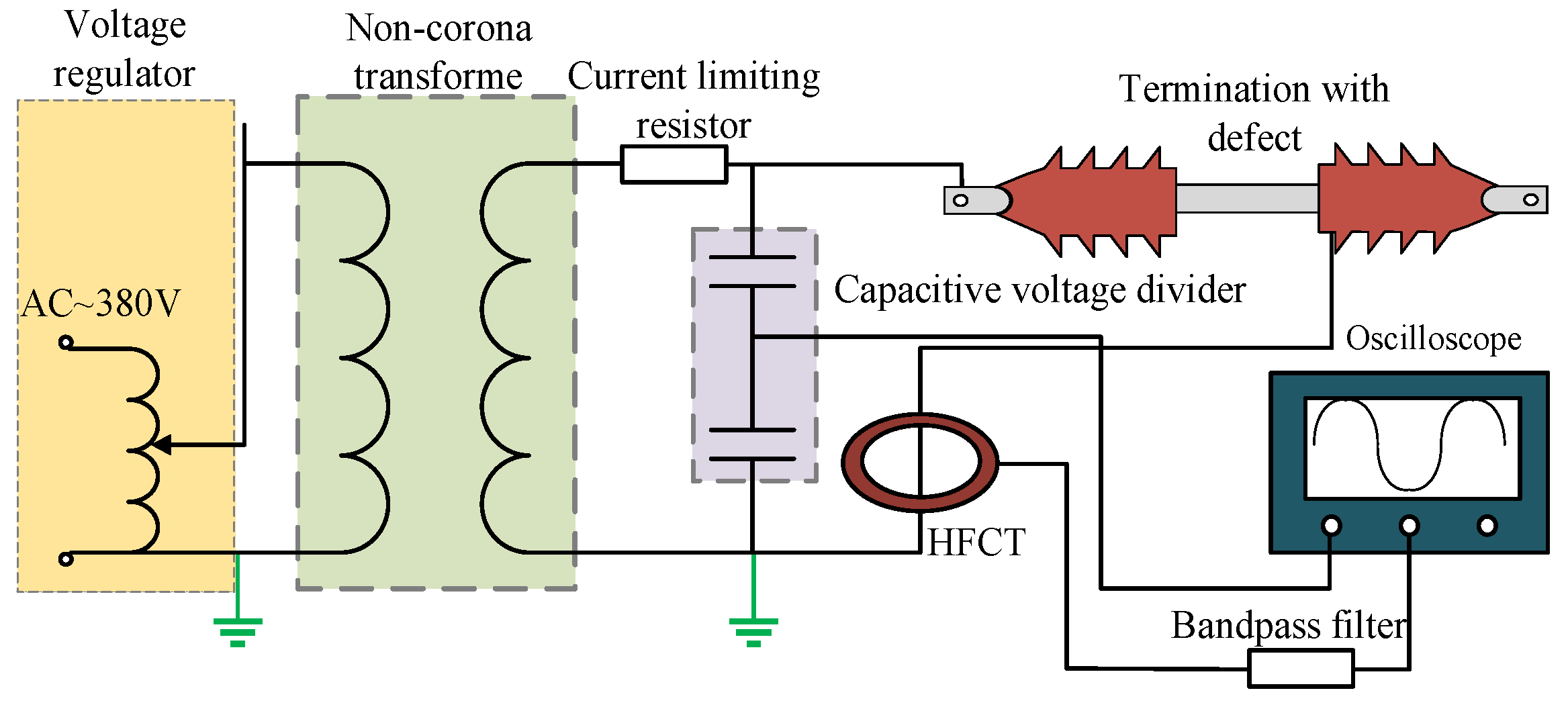
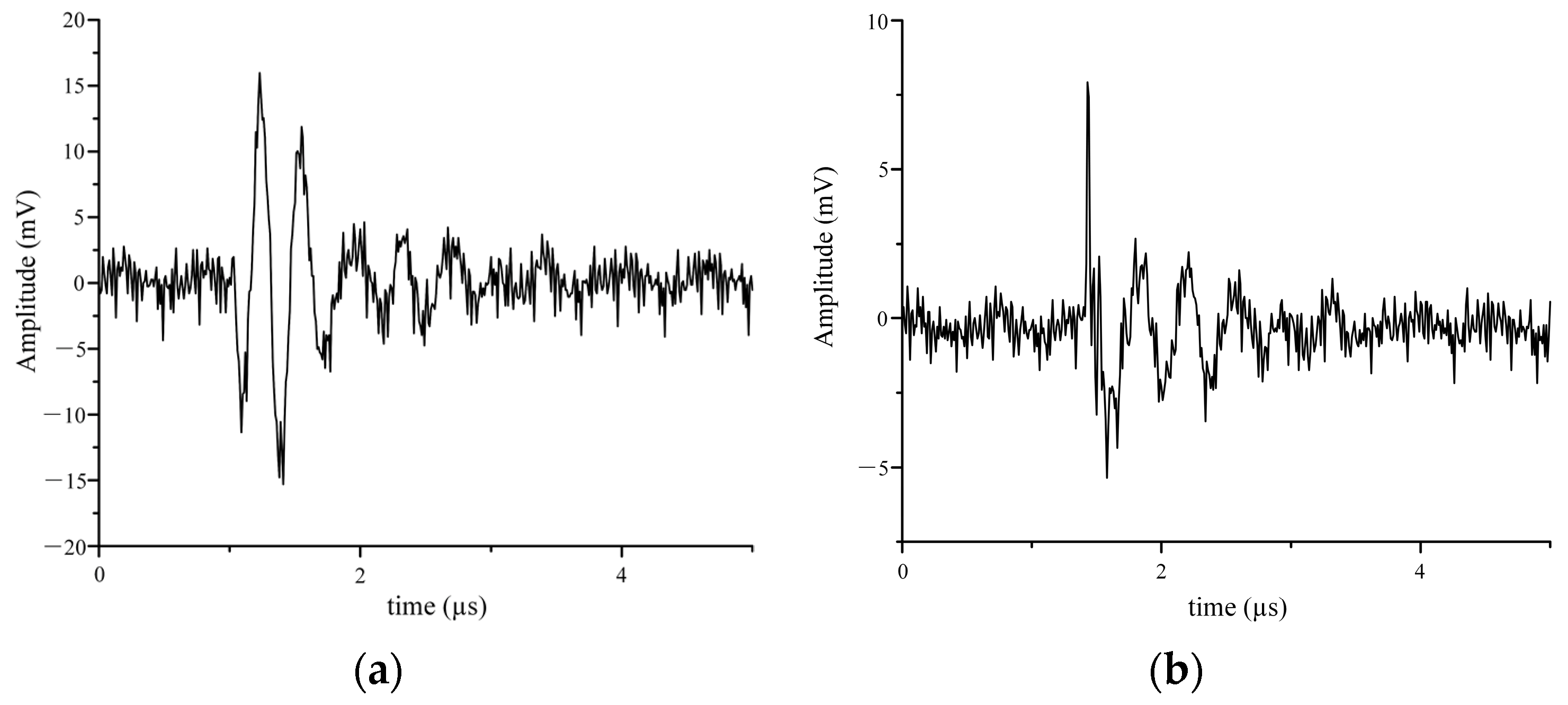


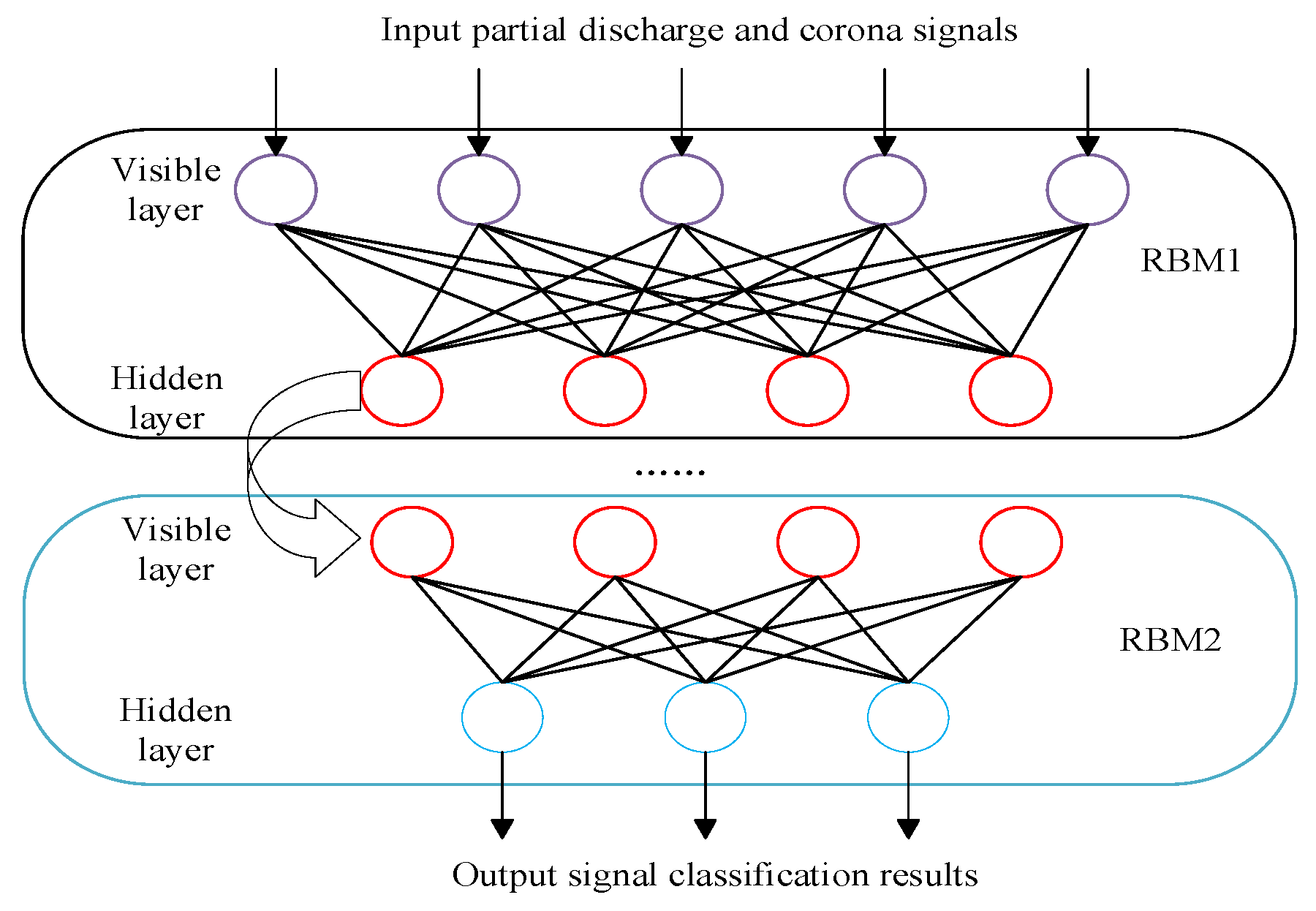
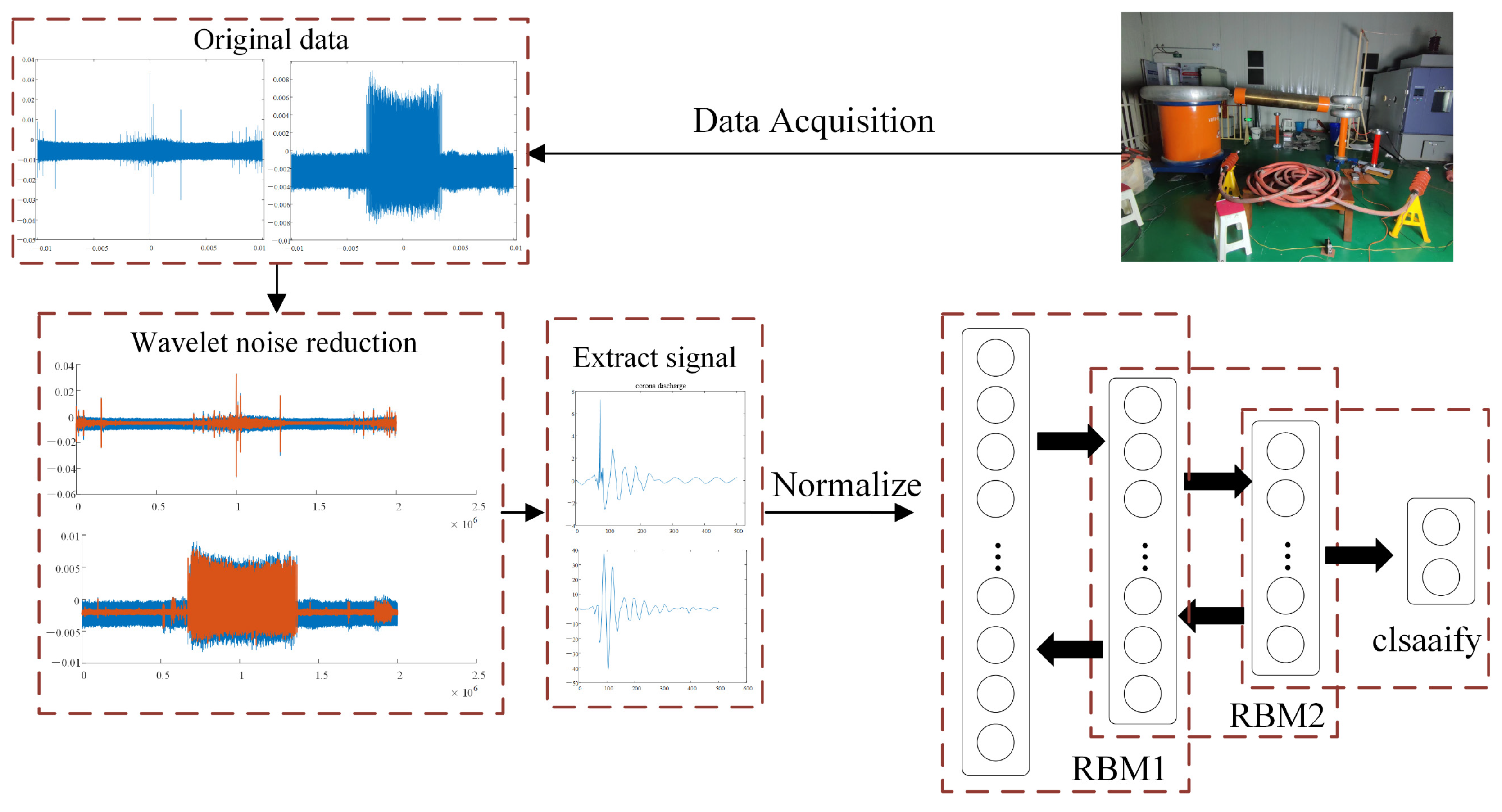
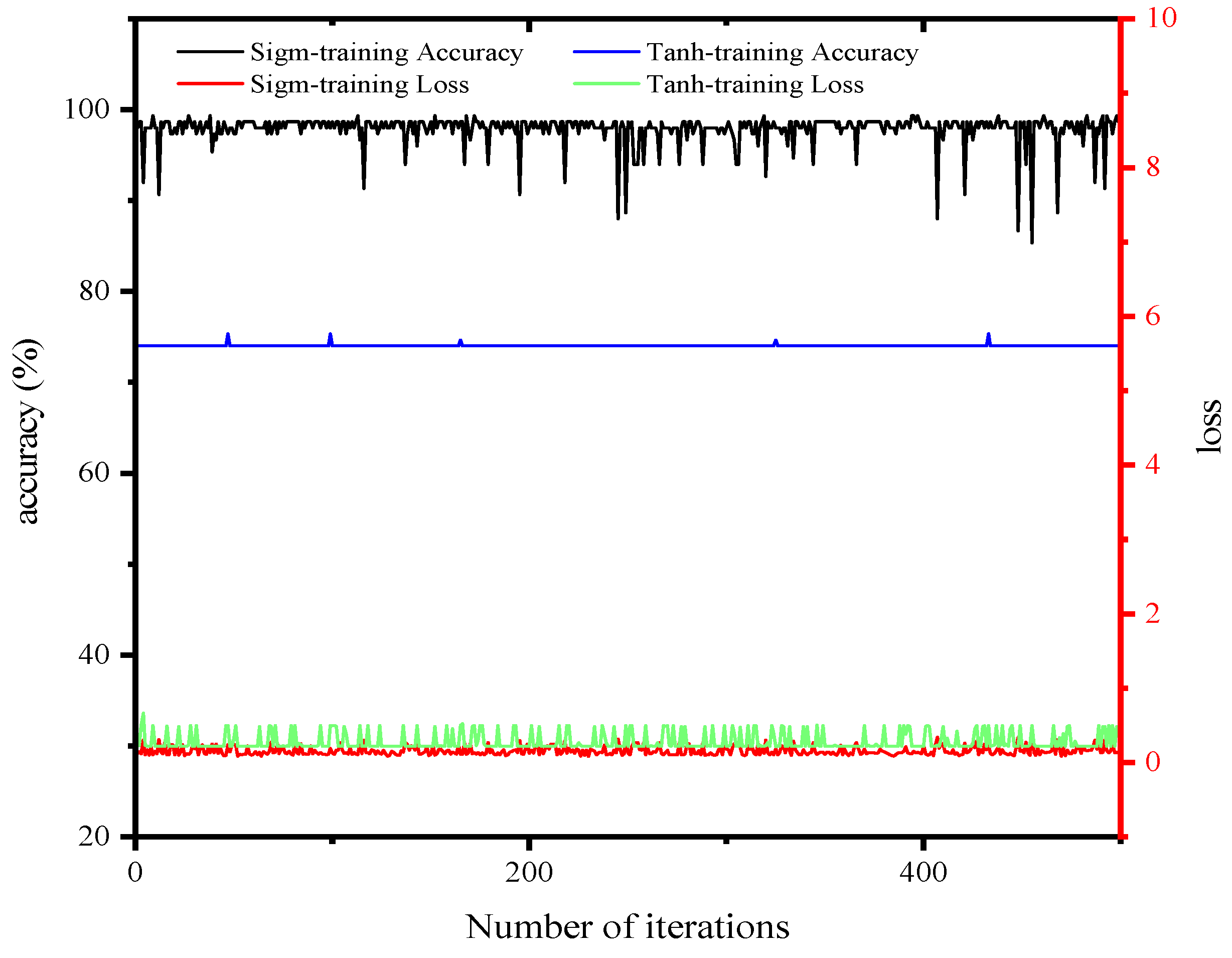
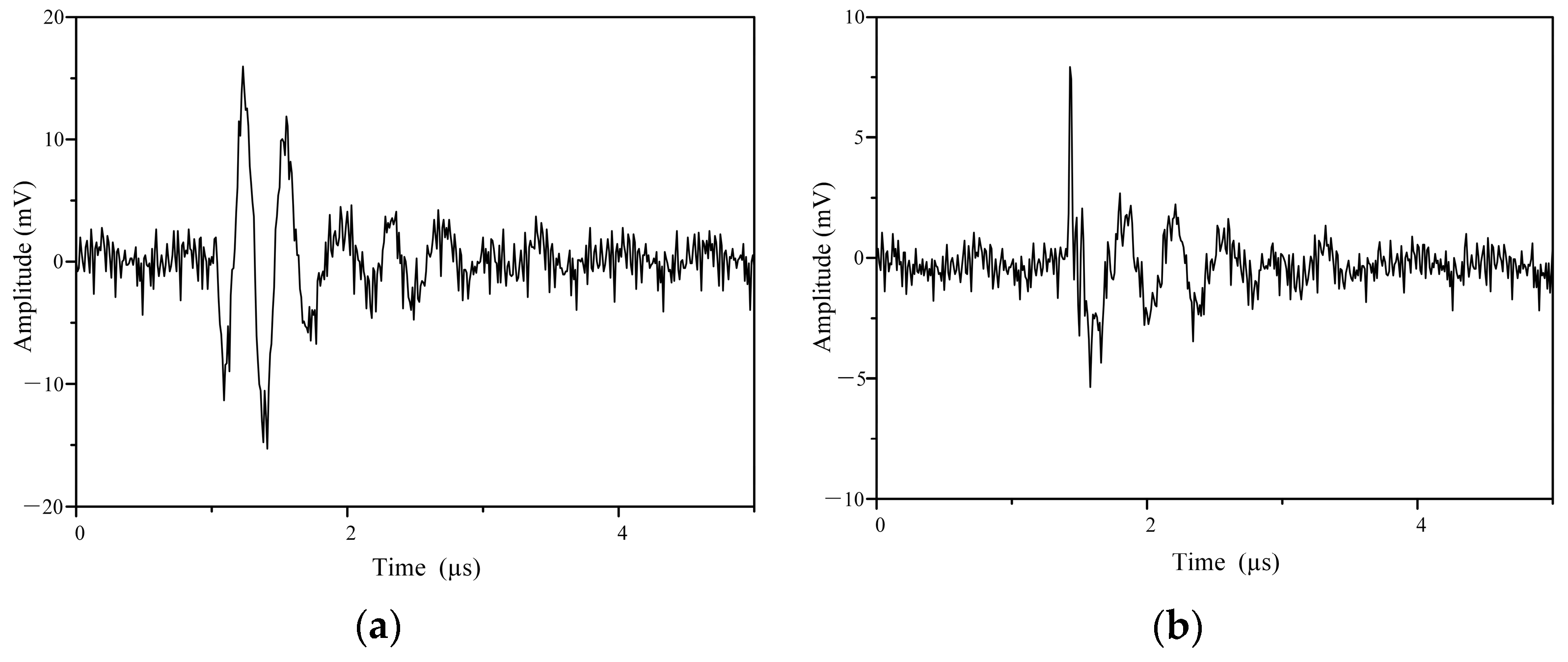
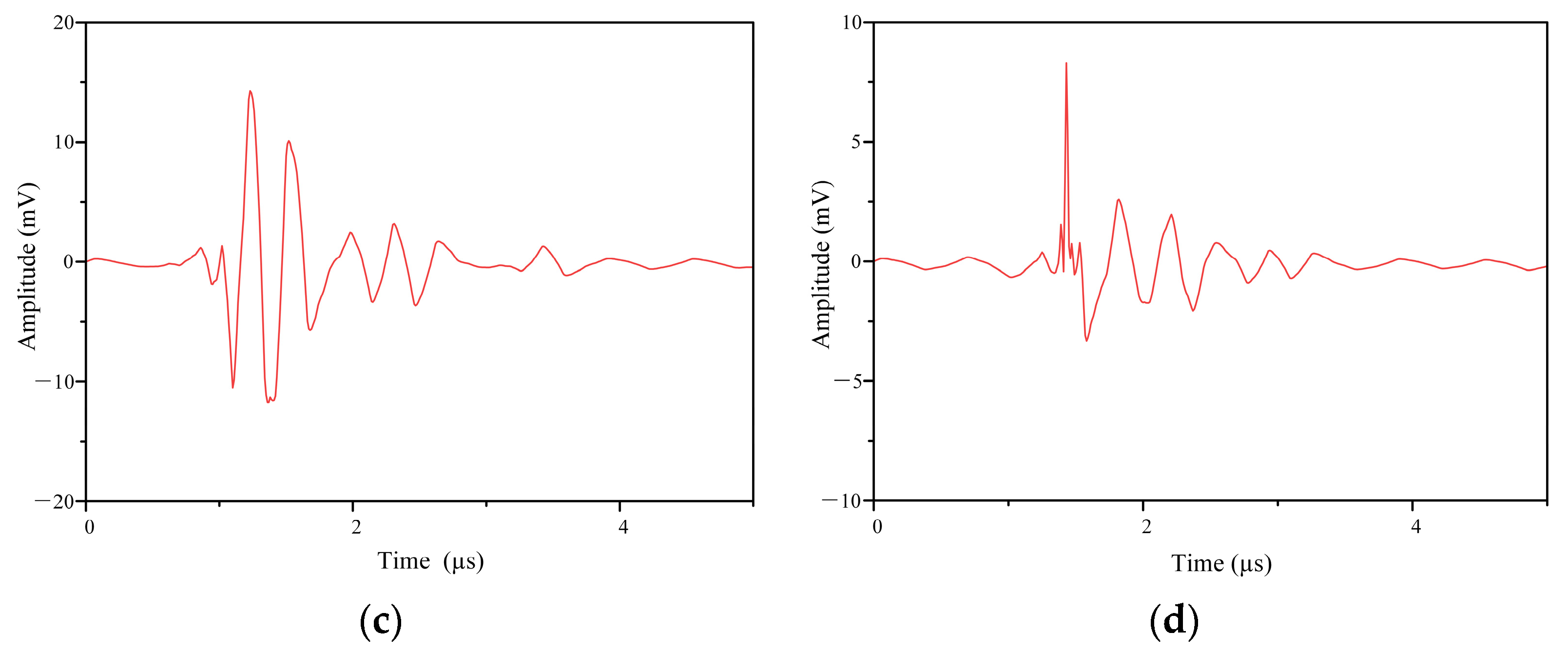
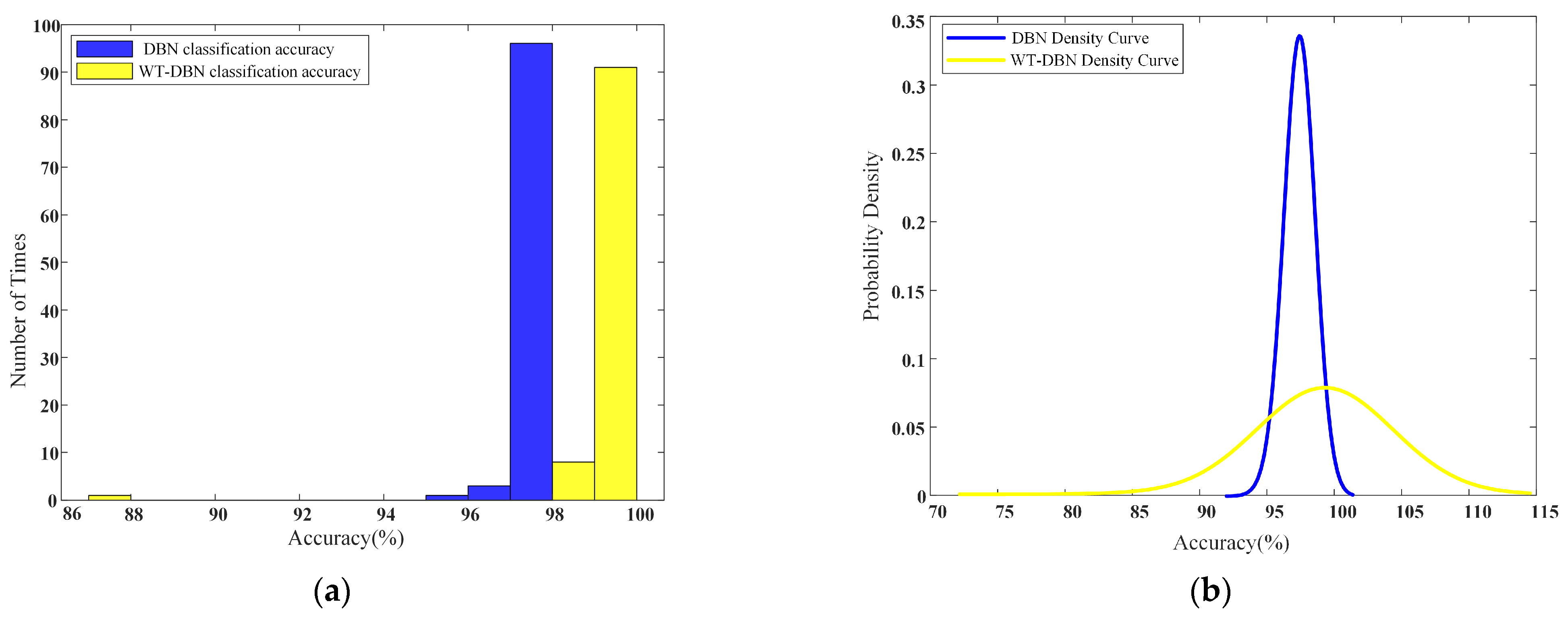
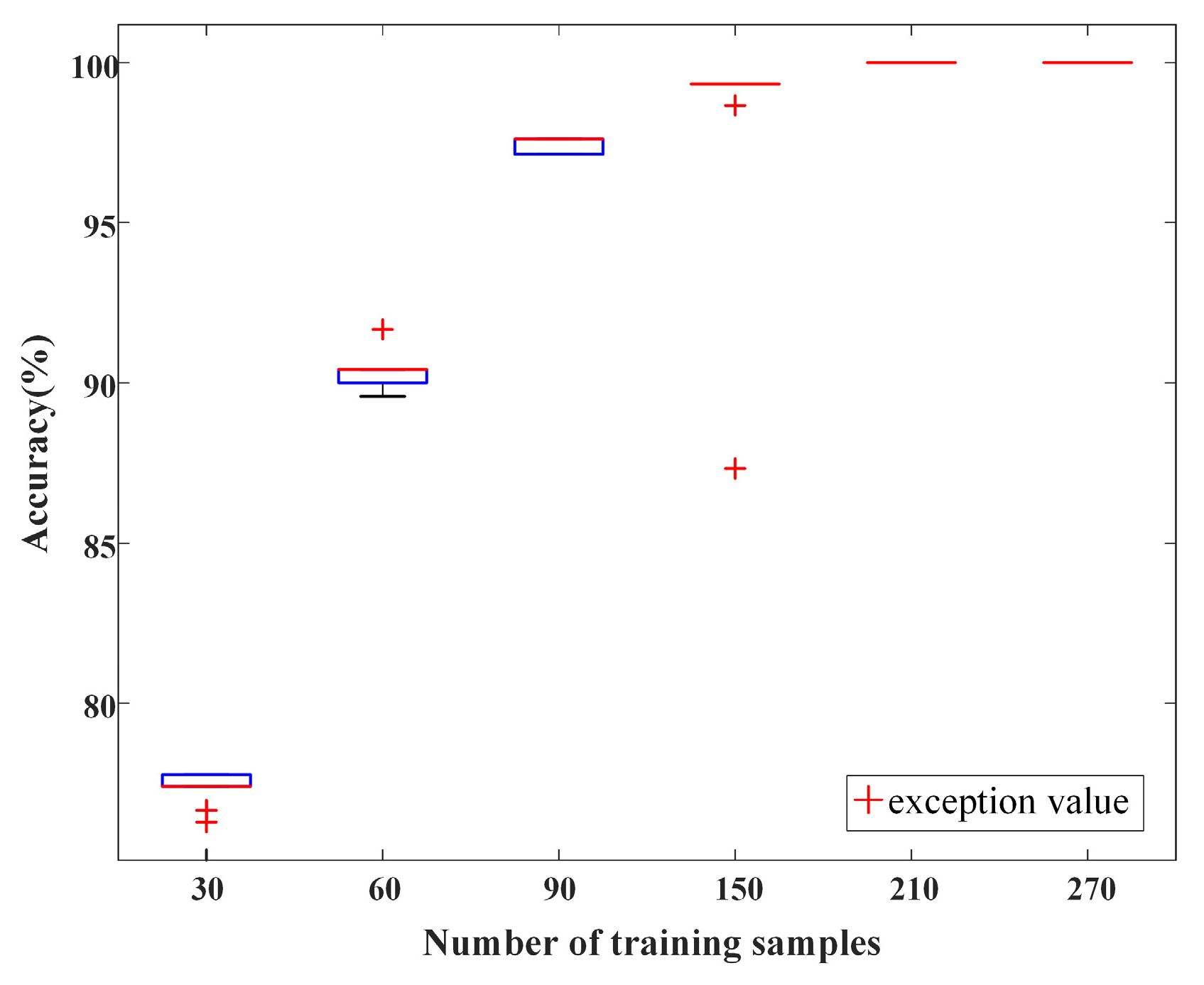
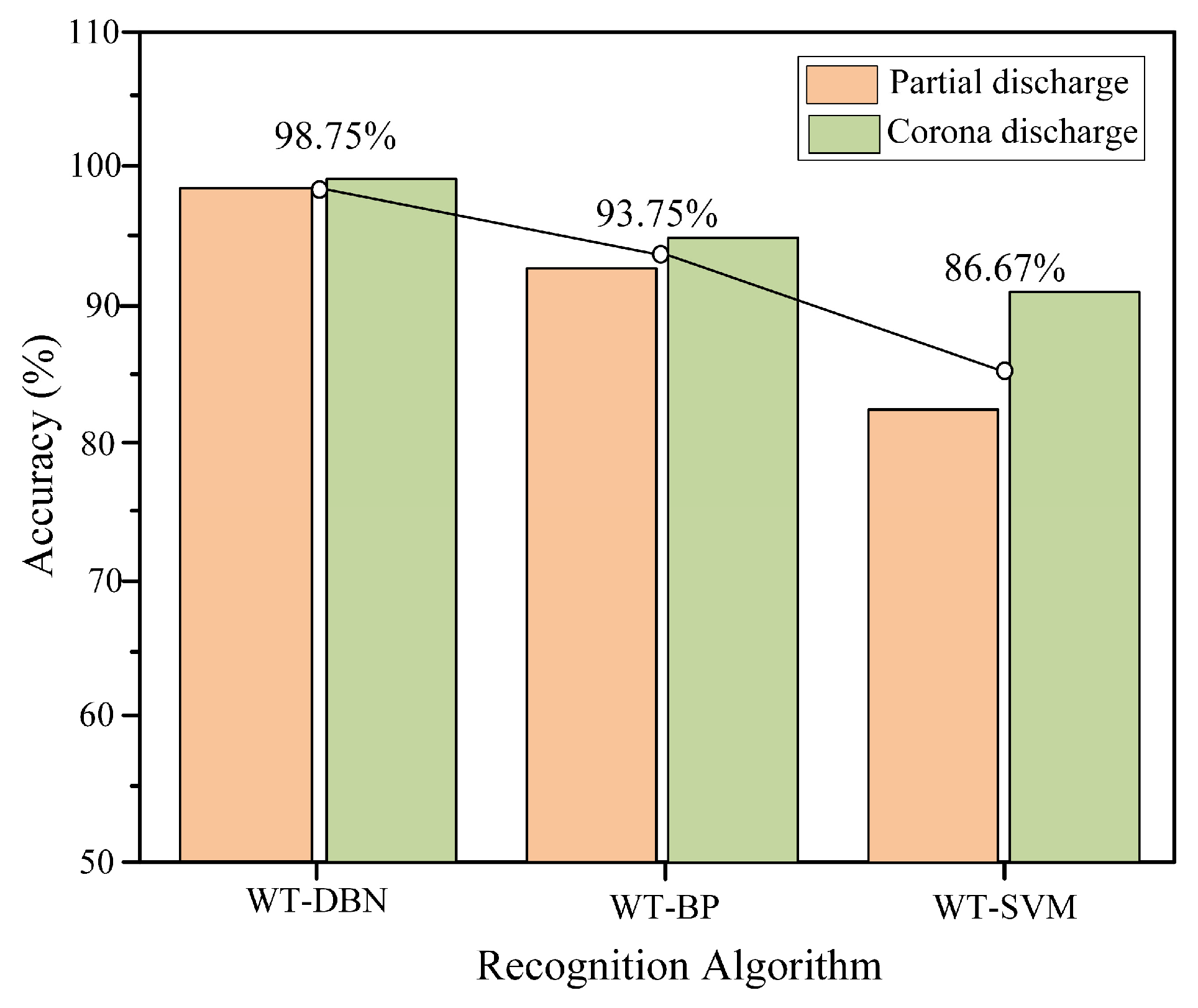


| Metric | Sigmoid | Tanh |
|---|---|---|
| Average Loss | 0.1671 | 0.2847 |
| Training Average Precision | 98.63% | 78.01% |
| Training Precision | 100% | 78% |
| Classification Precision | 97.17% | 74.01% |
| Training data | 30 | 60 | 90 | 150 | 210 | 270 |
| Verifying data | 270 | 240 | 210 | 150 | 90 | 30 |
| Discharge Type | WT-DBN | WT-BP | WT-SVM | |||
|---|---|---|---|---|---|---|
| Accuracy (%) | Average (%) | Accuracy (%) | Average (%) | Accuracy (%) | Average (%) | |
| Partial discharge | 98.33% | 98.75% | 92.5% | 93.75% | 82.5% | 86.67% |
| Corona discharge | 99.17% | 95% | 90.83% | |||
| Time used | 23.45 s | 65.75 s | 34.69 s | |||
Disclaimer/Publisher’s Note: The statements, opinions and data contained in all publications are solely those of the individual author(s) and contributor(s) and not of MDPI and/or the editor(s). MDPI and/or the editor(s) disclaim responsibility for any injury to people or property resulting from any ideas, methods, instructions or products referred to in the content. |
© 2024 by the authors. Licensee MDPI, Basel, Switzerland. This article is an open access article distributed under the terms and conditions of the Creative Commons Attribution (CC BY) license (https://creativecommons.org/licenses/by/4.0/).
Share and Cite
Liu, Z.; Li, J.; Zhang, T.; Chen, S.; Xin, D.; Liu, K.; Chen, K.; Liu, Y.-C.; Sun, C.; Gao, G.; et al. Accurate Identification of Partial Discharge Signals in Cable Terminations of High-Speed Electric Multiple Unit Using Wavelet Transform and Deep Belief Network. Appl. Sci. 2024, 14, 4743. https://doi.org/10.3390/app14114743
Liu Z, Li J, Zhang T, Chen S, Xin D, Liu K, Chen K, Liu Y-C, Sun C, Gao G, et al. Accurate Identification of Partial Discharge Signals in Cable Terminations of High-Speed Electric Multiple Unit Using Wavelet Transform and Deep Belief Network. Applied Sciences. 2024; 14(11):4743. https://doi.org/10.3390/app14114743
Chicago/Turabian StyleLiu, Zhengwei, Jiali Li, Tingyu Zhang, Shuai Chen, Dongli Xin, Kai Liu, Kui Chen, Yong-Chao Liu, Chuanming Sun, Guoqiang Gao, and et al. 2024. "Accurate Identification of Partial Discharge Signals in Cable Terminations of High-Speed Electric Multiple Unit Using Wavelet Transform and Deep Belief Network" Applied Sciences 14, no. 11: 4743. https://doi.org/10.3390/app14114743
APA StyleLiu, Z., Li, J., Zhang, T., Chen, S., Xin, D., Liu, K., Chen, K., Liu, Y.-C., Sun, C., Gao, G., & Wu, G. (2024). Accurate Identification of Partial Discharge Signals in Cable Terminations of High-Speed Electric Multiple Unit Using Wavelet Transform and Deep Belief Network. Applied Sciences, 14(11), 4743. https://doi.org/10.3390/app14114743








